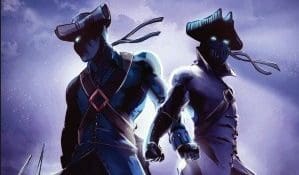Two escaped slaves get superpowers, team up with Ben Franklin, and wreak havoc on their corrupt former owner. This tells you all you need to know about The Sons of Liberty.
 This graphic novel, penned by Alexander and Joseph Lagos, is more National Treasure than history class, which is probably why it’s one of the most fun comics that I’ve read in a while.* Graham and Brody begin as slaves under the cruel Jacob Sorenson. When Sorenson’s son attacks Brody, Graham’s act of defense puts them both on the run, where they encounter Benjamin Franklin’s crazypants son, who has been electrocuting animals and, increasingly, slaves in effort to see what effect it has on their bodies. In this case, superpowers! (DO NOT TRY THIS AT HOME.) The boys proceed to befriend Ben Franklin, who gives them work in his print shop, and Quaker abolitionist Benjamin Lay, who teaches them the African martial art of dambe and suggests that they use their newfound powers to right the wrongs slavery has inflicted upon the country.
This graphic novel, penned by Alexander and Joseph Lagos, is more National Treasure than history class, which is probably why it’s one of the most fun comics that I’ve read in a while.* Graham and Brody begin as slaves under the cruel Jacob Sorenson. When Sorenson’s son attacks Brody, Graham’s act of defense puts them both on the run, where they encounter Benjamin Franklin’s crazypants son, who has been electrocuting animals and, increasingly, slaves in effort to see what effect it has on their bodies. In this case, superpowers! (DO NOT TRY THIS AT HOME.) The boys proceed to befriend Ben Franklin, who gives them work in his print shop, and Quaker abolitionist Benjamin Lay, who teaches them the African martial art of dambe and suggests that they use their newfound powers to right the wrongs slavery has inflicted upon the country.
Normally I’m irked by historical inaccuracy in books, but I make a gleeful exception for this one. After all, via Authors’ Note, the writers are pretty blatant about the historical inaccuracy (see again: superpowers), and most of the relevant inaccuracies are so ridiculous that they’re instantly noticeable. For example, while Benjamin Lay was truly eccentric and loudly anti-slavery (as depicted in the book) he also had a hunched back (as also depicted in the book), which logically seems like something that would interfere with the learning of most martial arts (not depicted in the book). William Franklin, too, is such an exaggeratedly despicable character that it’s hard to see anything that he does as historically-based (other than his strained relationship with his father, which was accurate). Such exaggerations permeate the book, from the fictional slave hunter who outfits his dog collars with foot-long spikes to a terrifyingly huge Hessian character who has no problem scalping a person with his bare hands. These are all the things of over-the-top action movies, which make it easier to suspend disbelief for this particular tale.
Graham and Brody, however, are decidedly non-exaggerated characters, which is what makes the story work so well. Most of the problems that they face in the story are problems that would be faced by any runaway slave—having to evade slave hunters, trying to find food without being conspicuous, worrying about the friends and family they left behind, etc.—and even once they acquire their powers, they react as one would expect teens in their situation to act—terrified at first, and then WHOA THESE POWERS ARE AWESOME. Surprisingly little of the story centers around their powers, too, but this is far from a flaw. Between Lay’s abolition efforts, Franklin’s conflict with William, William’s own several duplicities, and both of Graham and Brody’s conflicts (that is, hiding from Sorenson while learning to use their powers), there’s more than enough to keep the reader interested.
The writing itself zips between each storyline quickly, but never feels rushed. Dialogue is particularly well-handled, with several characters possessing their own unique styles of speaking. The art, too, is energetic, with smart use of color, expression, and character design, even if the lineart beneath the color occasionally looks too quickly-drawn. (It’s far from bad, but every now and then a character will look off-model. It’s not frequent enough to interfere with the reading experience, though.)
Ultimately, The Sons of Liberty is more concerned with entertainment than education. Considering that this was its goal in the first place, it does it with panache—so much so that it might even make readers interested in the true history behind the story! At its heart, it’s an exciting fantasy romp through pre-Revolutionary America, and highly recommended.
***
*No offense to history teachers. Mine were magnificent, but I’ve had several teens refuse historical fiction because they say their history teachers ruined it for them.

Leave a Reply